
|
 |
 |
 |
 |
 |
| Author |
Message |
    
M.Mc.
Unregistered guest
| | Posted on Thursday, February 05, 2004 - 9:47 am: |       |
Before I get into this point I would like to say I still find Sickert a weak Jack the the Ripper suspect. However, Sickert himself said he knew who Jack the Ripper was. So I wanted to talk about the 3 things that keep coming up about him. His paintings, the water-marked letters and his French alibi.
NOTE: for this thread I would like to point out that if Sickert was Jack the Ripper a good alibi would be a must. Sickert was a smart man but he did strange things and he was not all that nice a person. He only had a few friends at any given time but still wasn't a "tell all" person. Now it's been debated where Sickert was when Jack the Ripper was doing his wet work. Was he is France? Was he in England? Could he have gone to France been seen and then returned on a boat to England? Going from France to England is not that hard a task, less so in the 1800's than today. In fact someone took a swin between France and England some years back. So Sickert could have had a plan for a French alibi but to say so is just that. There is nothing to point that he did take a boat back to England. On the other hand if he was Jack the Ripper he would have made sure that his alibi was rock soild. Then there are some of his painting that may or may not be Ripper scenes. I will point out that one of his paintings is called, "Jack the Ripper's Bedroom" as a title. There is another called, "Jack Ashore" where a man leans over a hooker who is sitting up on a bed. There are a number of Sickert paintings that raise an eyebrow but they do NOT prove beyond a shadow of a doubt he was indeed Jack the Ripper himself. He may have painted Ripper type paintings just because he was an artist and this subject in press had given him the idea to paint gory images. It does not put Jack the Ripper's bloody knife in Sickerts hand. What about the water-mark on the Ripper letters that match Sickert's letters? Well these JTR letters are believed to be hoaxes anyway. So even if Sickert did indeed write these Ripper letters, he's not alone. Other people have jotted down fake Ripper letters and sent them out in the post. Sickert found things funny that others would not, that still does not make him Jack the Ripper. But just for this thread shall we take a look at some of his paintings? I have a few of them and would like to talk about them. Are they a window into the mind of Jack the Ripper or are they just a view of gore from an odd artist with strange taste?
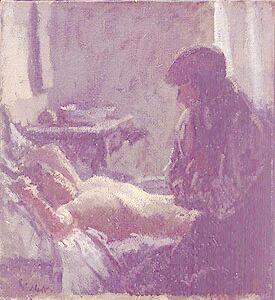
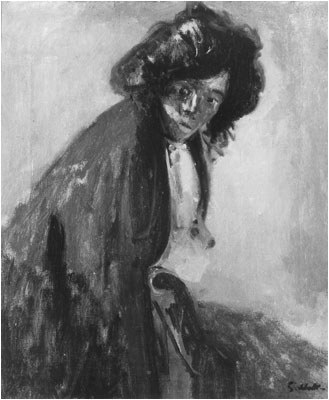
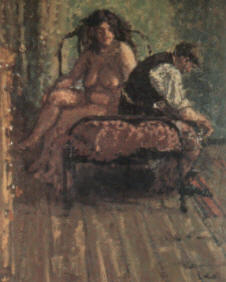
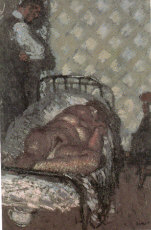
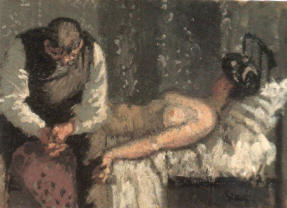
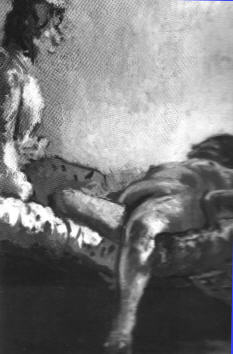
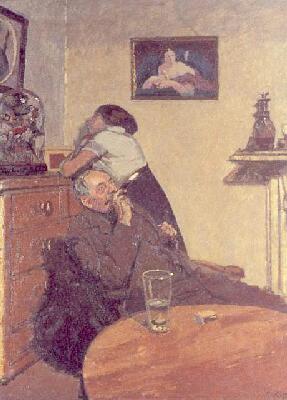
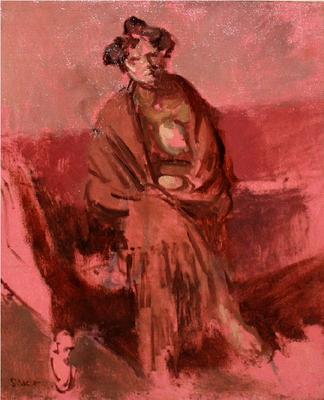
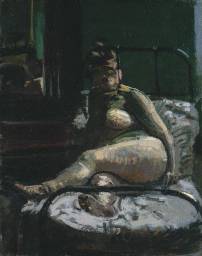
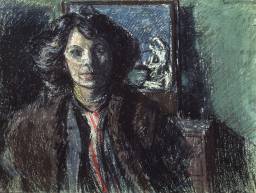
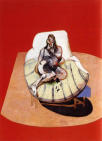 |
    
Tommy Nilsson
Unregistered guest
| | Posted on Tuesday, March 09, 2004 - 5:46 am: |       |
You can be very interested, or even very, very interested in Jack the Ripper and his crimes. Walter Sickert was possesed.
This obsession with death and violence shows all through his painting. Look at a painting from 1903,"Reclining Nude". Look at her eyes, looking in two directions.
That woman is dead. As Sickert himself said; "every picture tells a story". |
    
Tommy Nilsson
Unregistered guest
| | Posted on Wednesday, March 10, 2004 - 4:03 am: |       |
Sorry, the painting I was refering to "Reclining Nude", was painted in 1906 according to Wendy Baron, nr c 252 in her book (if my memory serves me right). Probably from the Camden Town Murder series and painted in Sickerts studio/home at Mornington Crescent. |
    
Mark Starr
Unregistered guest
| | Posted on Wednesday, March 10, 2004 - 6:47 pm: |       |
Tommy wrote:
>Look at her eyes, looking in two directions.
Thank you, Tommy, for a remarkably perceptive observation about this painting.
I suggest you examine also Sickert's "The Servant of Abraham." And you might be interested in my comments about this painting in the thread "A New Sickert Clue."
I do not have a good clear copy of "Reclining Nude," at least one that is detailed enough to show the woman's eyes. If you would post the image, particularly the face, I would be most grateful.
Regards,
Mark Starr
|
    
M.Mc.
Unregistered guest
| | Posted on Wednesday, March 10, 2004 - 2:44 pm: |       |
I have a few more of Sicket's panitings that seem Ripperish. However I don't believe works of art can be a clue to any type of killings.
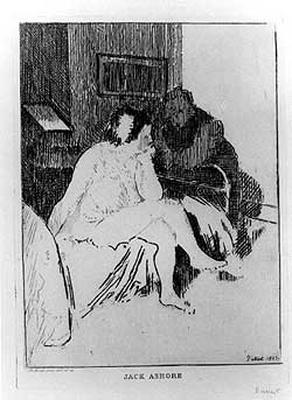
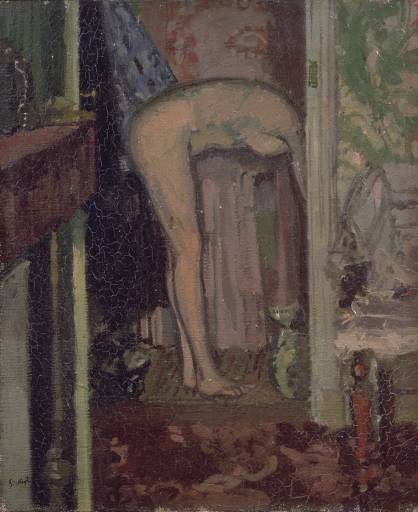
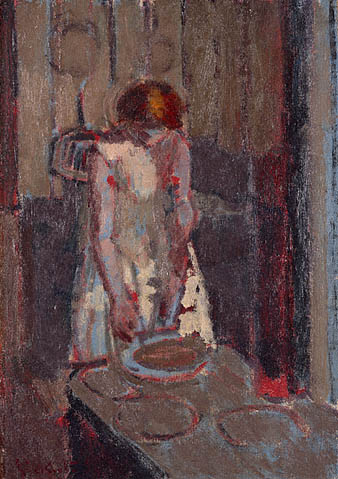
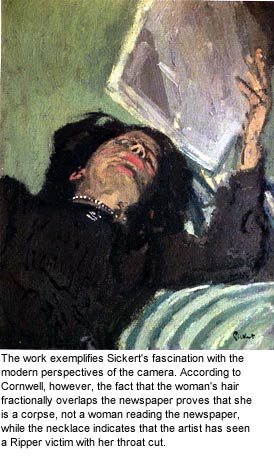
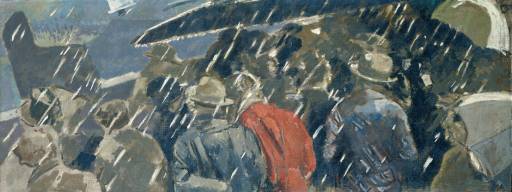 |
    
Mark Starr
Unregistered guest
| | Posted on Friday, March 12, 2004 - 2:33 am: |       |
Of the four painting you post, I would say only two have any relevance to JTR, the first and the third.
The Jack Ashore that you show here is an etching. Sickert painted several works with that title, including an oil. Here is the oil painting:
I am still trying to identify the meaning of Sickert's title. I have come across two English sea-faring songs that might be connected. The lyrics are:
Get Up Jack, John Sit Down
Ships may come and ships may go, as long as the seas do roll.
And a sailor lad, just like his dad, he loves his rum and bowl.
A lass ashore, he do adore, a woman who's plump and round.
But when your money's all gone it's the same old song,
"Get up Jack, John sit down."
Come along, come along, me jolly brave boys,
There's plenty more grog in the jar.
We'll plow the briny ocean with a jolly rovin' tar.
When Jack's ashore he'll make his way, to some old boarding house.
He's welcomed in with rum and gin, likewise with fork and Scousea.
And he'll spend and spend and never offend, 'til he lies drunk on the ground.
But when your money's all gone it's the same old song,
"Get up Jack, John sit down."
Come along, come along, me jolly brave boys,
There's plenty more grog in the jar.
We'll plow the briny ocean with a jolly rovin' tar.
Then Jack will slip aboard a ship bound for India or Japan.
In Asia there, the ladies fair, all love a sailor man.
He'll go ashore and he won't scorn, to buy some maid a gown.
But when your money's all gone it's the same old song,
"Get up Jack, John sit down."
Come along, come along, me jolly brave boys,
There's plenty more grog in the jar.
We'll plow the briny ocean with a jolly rovin' tar.
When Jack is worn and weather-beat, too old to sail about.
They'll let him stop in some grog shop, 'til 8 bells call him out.
Then he'll raise hands high and loud he'll cry, "Thank God I'm homeward bound"
But when your money's all gone it's the same old song,
"Get up Jack, John sit down."
Come along, come along, me jolly brave boys,
There's plenty more grog in the jar.
We'll plow the briny ocean with a jolly rovin' tar.
The second song is called: Jack Hink
When Jack comes ashore he's got money galore
And he's seldom cut short of a job
He can dress now as well as any can tell
With a good silver watch in his fob
Poor Jack in his life was ne'er paired with a wife
Though sometimes with lasses he links
He's a seafaring, sailmaking, gamboling, capering, grog-drinking hero
Jack Hinks, oh, Jack Hinks
When inclined for to spend he walks in with a friend
And with pleasure he sits himself down
He tips up his glass and he winks at the lass
And he smiles if she happens to frown
And like a rattling true blue when the reckoning comes due
On the table the money he clinks
He's a seafaring, sailmaking, gamboling, capering, grog-drinking hero
Jack Hinks, oh, Jack Hinks
Bound home the other fall we fell into a squall
Round the northermost head of Cape Friels
We were washed away without further delay
At the thought, how my spirit it chills
We were bashed on the rocks like a hard-hunted fox
Of death and destruction he thinks
He's a seafaring, sailmaking, gamboling, capering, grog-drinking hero
Jack Hinks, oh, Jack Hinks
Jack, without fail was out in that same gale
Having drove across Bonavist' Bay
On Neptune did rail as he hauled in all sail
And had his two spars cut away
Oh, but Providence kind that so eases the wind
And on sailors so constantly thinks
Saved that seafaring, sailmaking, gamboling, capering, grog-drinking hero
Jack Hinks, oh, Jack Hinks
About Sickert's painting, art critic Richard Cork has written: ...and Jack Ashore, Sickert�s characteristically erotic yet sinister painting executed around 1912, is accompanied in the collection by a study in pencil and red chalk as well as by an etching of the same subject, both produced around the same time. The crucial difference from Bomberg, though, lies in Sickert�s decision to use drawing �as a way of scaling down, in retrospect, one of his own paintings in order to transpose the image into an etching�. The end of Sickert�s fascination with the Jack Ashore theme only came a decade later, and the Wilson collection also owns the culminating print he eventually executed in 1923.
As for the terrifying painting of the woman with the newspaper, is she dead or alive? This is not the only Sickert painting to pose this question. Is the green behind her head the wall or a carpet? If the green striped object is a bedspread or a pillow on a couch, then why isn't she lying on it? The object curves down before her body. No support for her body there, just her left arm. To be reading, she would have to be in a very uncomfortable position. OK. so maybe she is unconfortable. From her expression, she is VERY unconfortable. To be lying on her back on the carpet, then the green striped object might be the side of a sofa or a chair. The to solving this painting puzzle is the non-descript object between her hand and her face, under the newspaper. What is it? A night-stand lamp? Then why is the light on the back of the newspaper. Well maybe the newspaper is at an angle to some light goes on to the back. Anyway, the painting is purposely ambiguous on the matter of life or death, just like so many of Sickert's paintings and actions throughout his life.
Regards,
Mark Starr |
    
Mark Starr
Unregistered guest
| | Posted on Friday, March 12, 2004 - 2:38 am: |       |
Walter Sickert
Jack Ashore
http://www.artunframed.com/images/sickert/jackashore.jpg
Regards,
Mark Starr |
    
Tommy Nilsson
Unregistered guest
| | Posted on Thursday, March 11, 2004 - 7:14 am: |       |
Hello Mark and everybody else interested in Walter Sickert and his paintings!
I�m an artist and former teacher in Sweden. Right now I�m working on an essay on Walter Sickert, hopefully finished next year. I�m also a student myself, in art science at Gothenburg University. I�m not used to write in english so you have to forgive me some errors...
My study deals (mainly) with the way Sickert paints women. I think that it was very unusual even in Victorian times. Why?
The more I see the more I find. I do believe that you can suspect Walter Sickert for being the Ripper if you take a close look at his work. He was obsessed by Jack the Ripper. But I think that it will be hard to prove, without any doubt...
Walter Sickert has been an inspiration for many painters in our time, like Francis Bacon. Walter Sickert is an icon. If art science was to say that every artist that deals with death and mutilation was a killer - then many artists would be arrested! In modern art a lot of artists are working with subjects of life and death, even bigger icons, like Marcel Duchamp. Art doesn�t want to be compromised. Today art (at least in some ways and for some people) has replaced religion. We want to forget everyday life and it�s problems with the help of art. Our artists should be special, but not killers. I think this is one reason for the resistance against investigating Sickert.
In my study I will have to deal with hard facts about the paintings.
In my free time I�m planing a study about Sickert that can deal with the issue of Jack the Ripper (in the long run it�s impossible not to deal with it, even in art science).
In his paintings he tells us a lot. Starting with is own selfportrait, the one that only shows his left side, kind of destroyed by paint.
The list of "strange" paintings is so very long, from around 1886 to at least 1935, have you seen "Jack & Jill" from that year? Or "Patrol", the painting of a police woman that Cornwell talks about. The title is painted to the left of the woman. If you look closely you can see a smal figure, a man in black suite, running (from the police?) but the police woman can�t see him. Her head has left her neck. Funny? Is this cruel humor or something else?
I believe it�s something else.
To Mark, I think that the three "religiuos" paintings is essential for our understanding of what Sickert became.
I like to read more litterature about Sickert and also what he himself wrote before I like to speak my mind in that matter. But there had to be som kind of crisis in his mind, if not remorse.
I would like to see more of Jack the Rippers drawings, can anybody help me? There is a possibility that you can link one of his drawings to one selfportrait. I�ll be back in this matter.
I do believe that Sickert wrote some of the Ripper letters.
I�m very interested in a better (lighter image) of "Jack the Rippers bedroom", and the painting "Death and the Maiden".
Kind regards, Tommy Nilsson
PS The woman in "Le Journal"(1906), is signed with an "S".
hanging from her necklace.
|
    
Tommy Nilsson
Unregistered guest
| | Posted on Thursday, March 11, 2004 - 7:25 am: |       |
To M. Mc, thank you for your pictures! I�ts a well known fact that some serial killers likes to take pictures or make videofilms of their victims.
In old times, you could paint them.
To Mark, I will do my best, as soon I find a scanner...
Regards, Tommy Nilsson |
    
M.Mc.
Unregistered guest
| | Posted on Sunday, March 14, 2004 - 10:49 am: |       |
No problem but I didn't post all the copies I have. Some were to large to post up here, I have a few more. I've seen much of Sickert's wooks due to the fact I'm an artist myself. I don't care much for his work, other artist from that era beat his work. Like Renoir just to name one better. However Sickert's art tends to have a dark side, even his beach one. It's of people at the beach but there is something cold about it. I still myself think Sickert is a weak JTR suspect as I do Lewis Carroll. However I do enjoy the ideas from both. |
    
Tommy Nilsson
Unregistered guest
| | Posted on Tuesday, March 16, 2004 - 6:06 am: |       |
To M. Mc. The last painting in your letter of feb 5 is made by Francis Bacon, but it showes that he was inspired by Sickert.
The painting "The French kitchen" has a lot to do with JtR. Look at her nose. Look at all the red paint. What is the expression? |
    
Tommy Nilsson
Unregistered guest
| | Posted on Tuesday, March 16, 2004 - 5:48 am: |       |
�Le Journal� was painted in 1906, according to Wendy Baron in her book �Sickert� and Richard Shone in his book �Walter Sickert�. Baron says that it was painted in Fitzroy Street, she recognizes the green white striped sofa. The painting is connected with studies of a woman with foreshortened (Barons word) head, believed to been made in Venice 1903. I think that one of these sketches is shown in Cornwells book, the one that Corwell says looks like the face of Ripper victim Mary Ann Nichols.
�Le Journal� is also connected to a lost painting made around the same time, �Head of a Woman�. The sitter for this painting is unknown. Sickerts friend, mrs. Swinton received a sketch at Easter 1906, this sketch was very close to �the profile portrait� in �Head of a Woman�. Mrs. Swinton thought that she is the woman in �Le Journal�, Baron is not sure, �after a lapse of some sixty years�.
�Le Journal� shows a woman resting on a sofa. She appears to be reading, �Le Journal�, but the journal is behind her hair, so in reality she is looking at something else. She has a golden ring on her hand.
Her black hair seems to be in disorder. Her left eye looks black, like it was closed, or missing. There is a red scar under the eye. The right eye is white and wide open. There is a red scare from her nose down to her right ear. Her ear is red. There is smaller red marks around her mouth, who is open. My over all feeling of her expression is that she is in disbelief , or in terror.
If you agree with the description above you have to ask yourself � where is her chin?
There is an alternative way of looking at her face. Her mouth is closed, the upper lip in the first description is her mouth. If you look closely you can see that the upper lip is divided, like it was two lips. This way of looking gives her a more silent expression�
In this case, she has a chin. The chin is red. There is a strange black shadow between her mouth and her chin.
She wears a necklace, of pearls? The necklace gives a strong black shadow. On her right side the shadow is under the necklace. On her left side the shadow is behind and over the necklace.
Connected to the necklace is the letter �S�.
Compare this painting with the photo of the victim Catherine Eddows in Corwells book.
Take a black and white copy and look and them together. Notice the arm and the ear.
There is no doubt in my mind, Sickert saw Eddowes. But did he see the picture of Eddowes or her dead body?
�Journal� can mean periodic newspaper, a doctors journal or a diary.
The �S� may mean signed, sealed, delivered.
|
    
Sarah Long
Chief Inspector
Username: Sarah
Post Number: 908
Registered: 11-2003
| | Posted on Wednesday, March 17, 2004 - 6:02 am: |       |
I've just been looking at these painting and can find nothing to suggest that he was the Ripper. Maybe he was influenced by him but only slightly. The one that looks most Ripperish to me would be the one is M.Mc's first post, the fifth painting down. That sort of reminds me possibly of the photo of Mary (obviously not her mutilations but just the angle or position of the bed or something) but that could easily be a coincidence as there are many paintings by him with a bed in it.
I certainly do not find the one of the woman reading the newspaper "terrifying" as Mark put it. It is obvious to me that she is lying on a bed reading a newspaper with her left arm propped up on the pillow and leaning back against the wall. I also certainly do not see how a necklace can possibly mean and cut throat.
Another thing, if Sickert made such an effort to get such a solid alibi (sneaking back and forth from France) then I don't see why he would then basically tell of his crimes through his art.
Also, why would he need an alibi? There was nothing linking him to the victims and no reason for the police to suspect him.
Sarah |
    
Tommy Nilsson
Unregistered guest
| | Posted on Wednesday, March 17, 2004 - 7:51 am: |       |
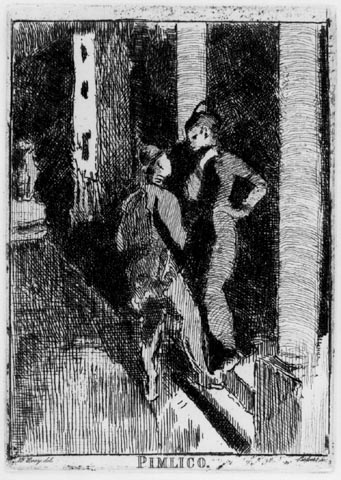
In 1888 the cut off arm of a woman was found in Pimlico. Walter Sickert made an etching named "Pimlico". There is no date for this etching.
A similar cityscape from the night is "Maple", the place where Camden Town victim Emily Dimmock walked the streets (says Cornwell).
Strange, isn�t it? |
    
M.Mc.
Unregistered guest
| | Posted on Tuesday, March 16, 2004 - 5:08 pm: |       |
OOPS! First I'd like say I'm sorry the last image I posted was the worng one I wanted to go up. Sorry about that people. However I think I've posted enough image copies of Sickert's work in any case. So I hope you enjoyed them? I still do not believe Sickert was JTR myself but some of his art work is pretty Ripperish nonetheless. |
    
Chris Scott
Assistant Commissioner
Username: Chris
Post Number: 1071
Registered: 4-2003
| | Posted on Wednesday, March 17, 2004 - 1:02 pm: |       |
I think it is not at all unusual for artists to be attracted to what the Victorians called the demi-monde, the world of vice and prostitution, often closely associated with the theatre and the music hall. One example who comes readily to mind is Toulouse Lautrec and his paintings and let us not forget that the famous ear cutting incident of Van Gogh involved his relationship with a prostitute- also, incidentally, an event which happened very close in time to the Kelly murder!
I cannot see any mystery in the title or the subject matter of Jack Ashore - the Ripper had no monopoly on a very common nickname and Jack or Jack Tar has been a nickname for sailors for a very long time. Any port town (and the east End, being near the docks) had a thriving prostitution industry to service the sailors and other mariners during their time ashore. Jack Ashore is just that - a painting/etching of a sailor visiting a protitute during his shore leave.
I have to agree with Sarah that I can see nothing terrifying or sinister in the painting Le Journal. With an impressionistic painter like Sickert whose technique, like other Impressionists, lies in broad marks and a lack of representational detail, it is tempting but risky to interpret individual marks as a black eye or a scar or whatever.
Hope these observations are of interest - by the way I am not puting van Gogh forward as a new candidate - he was safely in the south of France at the time!!!
Chris
|
    
Chris Scott
Assistant Commissioner
Username: Chris
Post Number: 1072
Registered: 4-2003
| | Posted on Wednesday, March 17, 2004 - 1:08 pm: |       |
Re the timing of the Van Gogh incident, this is the passage I was thinking of:
It was December of 1888 that he reportedly attempted to attack Paul Gauguin with a razor and later cut off the lower part of his left ear which he wrapped and gave to a prostitute in a brothel. |
    
Natalie Severn
Inspector
Username: Severn
Post Number: 474
Registered: 11-2003
| | Posted on Wednesday, March 17, 2004 - 4:26 pm: |       |
Hi Chris et al
For me quite honestly the idea of Sickert as Jack the Ripper is just so off the wall.
There were so many artists at this time vying with
each other to execute the most "decadent" paintings.Aubrey Beardsley managed to epitomise the movement,though he was a follower of Burne-Jones.I actually think it was called "The Decadent Movement" with lots of them behaving in a
"decadent" way [with preoccupations with prostitutes being a major hobby-to the despair of their wives].For further reading reading on the Pre-Raphaelites is advised-most of them were rich debauched and led the life of Riley.Alma Tadema was another of their ilk and it has been put forward on several occasions that one of his paintings can reveal who Jack the ripper was etc etc ad nauseum......
They were not wholly serious artists in the sense that Sickert was and Bomberg years later but a direct follower of Sickert as indeed are Bomberg"s pupils of today Frank Auerbach and Leon Kossoff[ and even to a certain extent Lucian Freud.But Auerbach who is a favourite painter in the National Gallery actually lives near Sickert"s old studio and is reputed to have been greatly inspired by him.
Sickert in his turn was a follower of Degas and Pissarro and geatly influeced by them though he carved out for himself a more radical/realist style that has been admired and has influenced the artists I refer to above.Sickert was a serious Artist even if the course he took wasnt perfected until Bomberg[an absolutely wonderful painter -1st rate and only recently beginning to be greatly admired[for political reasons apparently].Auerbach his pupil does keep the flag flying but for me he isnt as inspirational as Bomberg nor is Kossoff his other pupil.But it was our friend Sickert who led the way in all this.
Natalie |
    
Chris Michetti
Detective Sergeant
Username: Pl4tinum
Post Number: 65
Registered: 2-2004
| | Posted on Wednesday, March 17, 2004 - 4:58 pm: |       |
What a wierd image in the painting with the woman in the closet. Just above her back is a very wierd looking face.
Chris 
|
    
Sarah Long
Chief Inspector
Username: Sarah
Post Number: 925
Registered: 11-2003
| | Posted on Thursday, March 18, 2004 - 6:25 am: |       |
Chris,
Do you mean the one of the woman bending over? If so I can't see a face, but it does look like a big eye. That's probably just me though.
Sarah |
    
Tommy Nilsson
Unregistered guest
| | Posted on Thursday, March 18, 2004 - 9:35 am: |       |
To everybody who does�nt see anything strange in Walter Sickerts work.
Try to find Wendy Barons or Richard Shones books about Sickert and you have hundreds of paintings to examine. Look closely at each painting and compare them with the paintings of Degas, Whistler, Toulouse-Lautrec or Bonnard.
What more can I say?
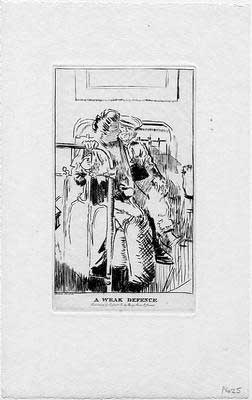 |
    
Glenn L Andersson
Assistant Commissioner
Username: Glenna
Post Number: 1305
Registered: 8-2003
| | Posted on Friday, March 19, 2004 - 8:40 am: |       |
Tommy Nilsson (Tjena Tommy!) wrote:
>My study deals (mainly) with the way Sickert paints women. I think that it was very unusual even in Victorian times. Why?
It was not unusual at all; from the years of 1890 to 1910, we have a large number of artists and paintings depicting women in such a fashion and dealing with these kind of themes. So therefore it's important to look at the social agendas that was dominant in this time period.
Natalie is absolutely correct; during this time period the "decadence" movement was in full bloom, and the female and the female sex was seen as a great threat against moral and society in general.
I have a couple of times put forward Edvard Munch as an example. He depicted women as vampires and the female sex as something threatening against himself and all mankind. He was indeed a disturbed man, but he was not a serial killer. Neither can Sickert's paintings lead to similar conclusions. It is just silly.
As an art historian and former painting artist, I am quite aware of the fact that art interpretation is a completely subjective form of analysis, and what we see lies for the most part in the eye of the beholder. Artists can indeed be very obsessive with certain subjects, but that means nothing in this context. The paintings only manages to confirm his obsession, if they even do that.
I can't see any clues whatsoever in his paintings in order to suggest that he was Jack the Ripper. We can see a lot of weird things in Sickert's work, and I must admit that "The Journal" scares the hell out of me. But that wouldn't be the first time I've seen similar works throughout art history, and probably not the last. Artists may be occupied with strange themes, but it doesen't make them serial killers.
All the best
(Message edited by Glenna on March 19, 2004)
Glenn Gustaf Lauritz Andersson
Crime historian, Sweden |
    
Alan Sharp
Chief Inspector
Username: Ash
Post Number: 532
Registered: 9-2003
| | Posted on Friday, March 19, 2004 - 8:45 am: |       |
What more can I say?
Er, well you'd need to say quite a lot more than that, anyway. Exactly how does comparing Sickert with any other artist demonstrate anything. Quite apart from that, I have always regarded Sickert and Pierre Bonnard to have very similar styles.
Talking of which, take a look at Bonnard's "Nude Reclining on a Bed" (Musee d'Orsay, Paris). This is one of the most erotically charged paintings I have ever seen, on my visit to the Orsay it took my breath away. In the painting a naked slender girl lies back on the bed, one knee drawn up, the other straight out, her hands up by her head, her whole aspect is one of sated sexual lust. The shadows in the room and the rumpled bedsheet next to her indicate the presence of a second person in the room, but there is no more information than that as to who that person might be (or even which gender).
And hey, she has her eyes closed. Now someone could interpret this painting as saying that she is dead, and the looming presence in the room is her killer.
Art is subjective. |
    
Natalie Severn
Inspector
Username: Severn
Post Number: 479
Registered: 11-2003
| | Posted on Friday, March 19, 2004 - 9:41 am: |       |
Those posts-Alan and Glenn say it so well,I mean such a lot of Art in the past was about rape for example-therape of the Sabine women seems to have beeen painted by everyone and some of them I cant bear to look at.Ditto murder scenes.Sickert was quite clear about what he wanted to achieve and
it was to do with reality,people were not prettified,life is sometimes grotty and unpleasant a whole world is outside there noone wants to paint so I will.Thats why for example Auerbach thinks he is so wonderfull In England anyway he was the only one to turn away from pretty pretty art to something that approximated many many people"s lives not the protected world of the bourgeois[though he came from that world]
but the world of ordinary people including your down and outs.The ordinary people who went to music halls and enjoyed Marie Lloyd etc
And this "movement" had some parallel in writing
and drama with the likes of Elizabeth Gaskell
and Charles Dickens in earlier Victorian England and Emil Zola in France.
The Greatest painter in this type of genre for me is Manet whose painting of a young girl in La Bar aux Folies Bergeres[meant to be a young prostitute being propositioned]is one of the lovliest paintings of the 19th century.
Alan _I know Bonnard also a brilliant painter.
Glenn Munch-tremendous stuff he did too.
Why dont you do some paintings for us-I"d love to see them!
Best Natalie |
    
Glenn L Andersson
Assistant Commissioner
Username: Glenna
Post Number: 1306
Registered: 8-2003
| | Posted on Friday, March 19, 2004 - 9:53 am: |       |
Just as a personal note to Natalie, outside the thread:
I've seen your paintings and I find some of them very interesting. They do have atmosphere, especially the street scenes. Keep it up! 
Oh, it's been too long now since I've been holding a brush for serious attempts. There was a period in my life when I did it for a living, though, and I may be picking it up again in the near future. I do have some photos somewhere of my old stuff -- quite realistic paintings of people and interiors (quite similar to yours, although my style would be considered more as strict and dogmatic photorealism or naturalism), but I get back to you if I can find them.
Yes, Munch was an interesting artist, and regardless of the personal problems he had, he found inspirations in them and he always manages to leave the viewer affected in one way or the other.
Cheers, Natalie.
All the best
(Message edited by Glenna on March 19, 2004)
Glenn Gustaf Lauritz Andersson
Crime historian, Sweden |
|
Use of these
message boards implies agreement and consent to our Terms of Use.
The views expressed here in no way reflect the views of the owners and
operators of Casebook: Jack the Ripper.
Our old message board content (45,000+ messages) is no longer available online, but a complete archive
is available on the Casebook At Home Edition, for 19.99 (US) plus shipping.
The "At Home" Edition works just like the real web site, but with absolutely no advertisements.
You can browse it anywhere - in the car, on the plane, on your front porch - without ever needing to hook up to
an internet connection. Click here to buy the Casebook At Home Edition.

|
 |
 |
|



















